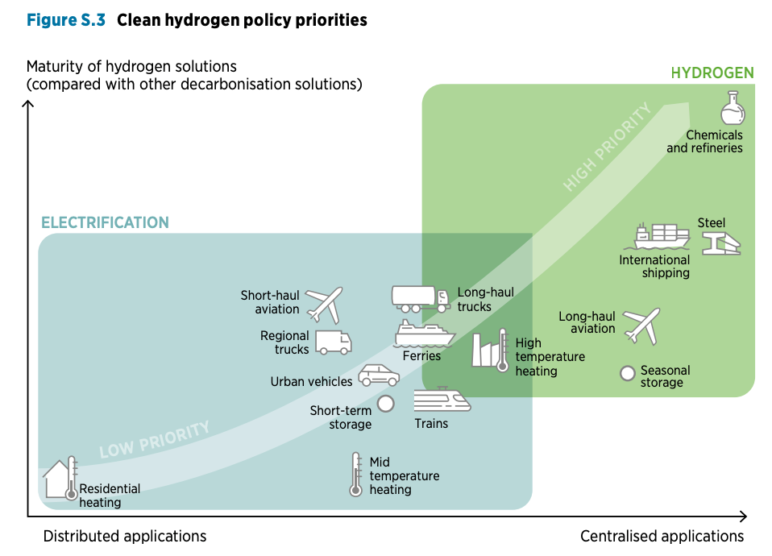Takeaways
Cascadian utilities are rushing to bet big on renewable hydrogen to heat homes and buildings.
But the fuel is ill-suited to this application—more expensive, dangerous, and energy-intensive than the alternative: electrification.
The region’s lawmakers and regulators should carefully study, define, and prescribe the best uses for this hydrogen, of which there are some. Heating buildings just isn’t one of them.
This would best serve ratepayers and honor the region’s commitments to a decarbonized future.
Find audio versions of Sightline articles on any of your favorite podcast platforms, including Spotify, Google, and Apple.
“We’re very bullish on renewable hydrogen,” hyped a representative from NW Natural, Oregon’s largest gas utility, when testifying in support of a 2021 hydrogen bill in Oregon. Hydrogen enthusiasm is at an all-time high, with the recent passage of multi-billion dollar subsidies by federal policy makers and major oil and gas corporations backing hydrogen projects, including Northwest utilities. Proponents of the fuel envision a future in which hydrogen—and specifically a strain of it being marketed as “renewable hydrogen”—heats homes and businesses, powers trains and cars, and balances the electric grid.
Renewable hydrogen, also known as green hydrogen, does have its place in a climate-friendly future, namely in cleaning up hard-to-decarbonize sectors like steelmaking, long-haul shipping, and aviation, and in generating electricity during windless, cloudy periods. Plus, existing hydrogen consumers, like petrochemical refineries, metallurgical industries, and ammonia and fertilizer manufacturers, could reduce their emissions by switching from hydrogen produced by fossil fuels to hydrogen produced from renewable electricity (see our primer on the different types of hydrogen).
But natural gas utilities, including those in Cascadia, have their eyes on a much bigger prize: pumping hydrogen through the natural gas pipeline system to heat buildings—and raking in the accompanying profits. Unfortunately, hydrogen is not the solution these fossil fuel corporations make it out to be, nor should it be their next cash cow. It merely delays the much-needed shift to electrification, holding ratepayers subject to more expensive fossil fuel infrastructure and a more dangerous and less efficient fuel—all while slowing progress toward the region’s decarbonization goals. Lawmakers and regulators should beware the industry’s hype as they weigh hydrogen’s permitted uses.
Hydrogen for home heating scores low on efficacy, cost, efficiency, and safety
Despite being touted by natural gas utilities as the best path to clean home heating, hydrogen is much less effective at decarbonizing buildings than is electricity. Only small volumes of hydrogen, perhaps up to a ratio of 20 percent hydrogen to 80 percent natural gas, can safely be injected into existing gas pipelines. But a 20 percent blend of hydrogen only shaves off around 7 percent of the combustion emissions of a system running on 100 percent natural gas. Put in context, in Washington, for example, buildings’ emissions will need to decrease 96 percent by 2050 for the state to meet its legislated decarbonization commitments.
What’s more, blending higher ratios of hydrogen into existing natural gas infrastructure to achieve greater emissions reductions could cost billions. Most gas distribution pipelines would need to be replaced or extensively retrofitted to safely accommodate the new fuel, since at higher volumes than 20 percent, hydrogen can degrade pipelines. Plus, higher ratios of hydrogen are incompatible with existing appliances like stoves and water heaters, meaning consumers would also need to buy new hydrogen-compatible appliances. These replacement requirements and associated costs are why major studies for the Northwest conclude that wide-spread electrification is the least expensive pathway to decarbonize building.
Plus, hydrogen is less efficient than electricity at heating homes. A 2021 study found that heating a home with green hydrogen has an efficiency of around 46 percent.1 Heating a home with an electric air-source heat pump, on the other hand, has almost six times that efficiency, at around 270 percent. Yes, hydrogen could provide carbon-free heat in a home, but heating with hydrogen demands nearly six times as much renewable electricity as does an electric heat pump. Heating with hydrogen, in other words, is like drying your dishes with a blow torch.
Lastly, hydrogen introduces serious safety concerns. Hydrogen ignites more easily than natural gas. Flammability, coupled with pipeline integrity vulnerabilities from too-high blends of hydrogen, is a recipe for catastrophe. Serious injuries would increase nearly four-fold if hydrogen wholly replaced natural gas, according to a 2021 study conducted for the UK government. Even at modest concentrations of hydrogen in a natural gas pipeline, scientists are raising red flags. “The overall risk is significantly increased for all hydrogen levels, and it becomes severe at hydrogen levels above 20 percent,” according to an analysis by the US Department of Energy’s National Renewable Energy Lab in Golden, Colorado. Hydrogen is also invisible and odorless, and thus far, no odorants have been identified that could be applied to hydrogen to detect leaks.
Given the challenges around efficiency, cost, effectiveness, and safety, it is little surprise that home heating is the lowest priority among 15 possible hydrogen uses identified by the International Renewable Energy Agency, as shown in the graphic below.

International Renewable Energy Agency, Abu Dhabi.
Cascadian utilities are rushing to bet big on hydrogen; Lawmakers and regulators beware
Hydrogen heating in Cascadia isn’t a far-off aspiration; it’s an active business plan by regional gas utilities. Both Puget Sound Energy (PSE) and NW Natural, Washington and Oregon’s largest gas utilities respectively, have already entered into project commitments to pump hydrogen through their natural gas distribution pipelines. NW Natural envisions injecting hydrogen into its natural gas pipeline for “transportation, heating, manufacturing and other processes” and told its investors that it intends to meet its carbon neutrality goal by displacing natural gas with hydrogen to avoid 20 to 58 percent of its emissions. Earlier this year, PSE filed its general rate case, which included $6.6 million for hydrogen blending pilots over the next 3 years. Cascadia’s other gas utilities, Fortis BC, Cascade Natural Gas, and Avista, are also eyeing the possibilities with hydrogen.
Regrettably, lawmakers Oregon and Washington and regulators in British Columbia have laid the groundwork to heat buildings with hydrogen, authorizing gas utilities to sell green hydrogen. If lawmakers and regulators in Cascadia are serious about meeting the region’s climate commitments, they would be wise to study gas utilities’ hydrogen proposals carefully and place limits on hydrogen’s allowed uses. While a small emissions savings from a lower hydrogen-to-natural-gas blend ratio might be attractive in the near term when buildings haven’t widely electrified, investment requirements and safety risks are high for these low volumes of hydrogen must be weighed against alternatives—namely, electrification.
In sum, despite a growing body of studies concluding building electrification offers the lowest-cost, most efficient path to lowering emissions from buildings’ energy use, Cascadia’s gas utilities are aggressively pursuing a risky alternative route: hydrogen. Allowing them to deploy hydrogen for heating buildings, as they are on the brink of doing, would be a colossal miscalculation and would undermine Cascadia’s climate progress. Without the region’s leaders enacting definitive policy and regulation on hydrogen’s best uses, Cascadians will see gas utilities make costly investments to expand their infrastructure in the name of an unrealistic and potentially dangerous route to home heating.



Comments are closed.